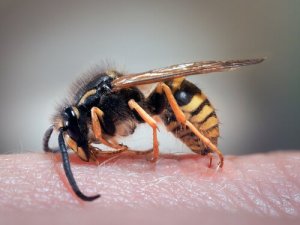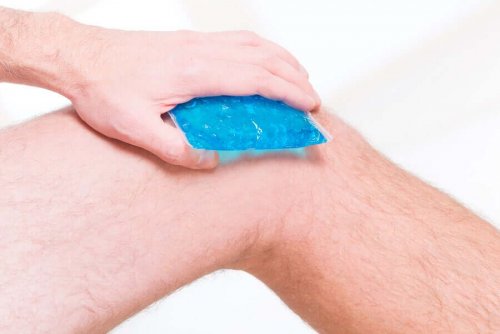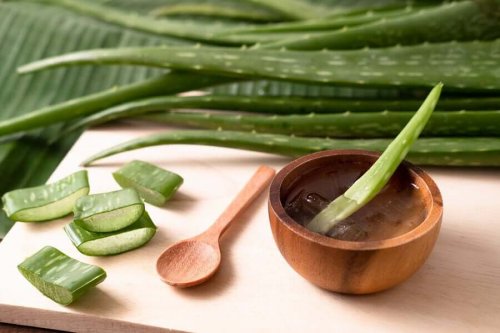Home Remedies for Wasp Stings


Written and verified by the doctor Leonardo Biolatto
The pain caused by wasp stings usually gets better by itself after a few hours. However, some people need a remedy to alleviate it, since it can be very uncomfortable. Fortunately, as long as there are no signs of an allergic reaction, it’s something you can easily fix at home.
If you have an allergic reaction to a wasp sting you should seek immediate medical attention, since there is a risk of anaphylactic shock. This is a serious reaction that can cause rashes, difficulty breathing, dizziness, and other complications that can lead to death.
Fortunately, this type of reaction is not very common, and most of the time the discomfort of a sting can be treated naturally, with home remedies and basic care. We’ll explain some useful remedies below.
Useful remedies for pain caused by wasp stings
When you are faced with pain from a wasp sting, it’s important to learn the proper way to respond. So, the first thing you should do is check to see if the stinger is still in your skin. If it is, you have to take it out carefully, scraping your skin lightly with the edge of a credit card.
Then, you should clean the area with warm water and neutral soap. If you have an antiseptic, it’s a good time to use it. But what can you do for the pain and swelling? After a few minutes you might experience burning and pain.
To alleviate these symptoms, you can use some remedies with natural ingredients. However, you should keep in mind that they provide temporary relief and aren’t always effective. Most of them come from popular beliefs and there isn’t always evidence of their effectiveness against these symptoms.
You might be interested in: What to Do After an Asian Hornet Sting
Cold compresses

A cold compress is a good option to reduce the pain caused by wasp stings. In fact, you should use it on the affected area as soon as you disinfect it. According to a publication from the library of health at Rochester University, the cold reduces the pain by numbing the affected area of your body. Additionally, it helps reduce swelling.
How to use them
- You have two options to make this remedy. The first is to wet a towel with cold water and put it in a ziplock bag. Then, put it in the freezer for 15 minutes. After that, hold it against the affected area.
- Another option, which is faster than the first, is to wrap ice cubes in a towel or cloth. Immediately use it to gently massage the area of the sting.
Essential oils
To date, there isn’t evidence to relate essential oils to alleviating the pain caused by wasp stings. However, many people have used them as a calming and antiseptic remedy.
According to a study published in Evidence-Based Complementary and Alternative Medicine, essential oils have antimicrobial properties that reduce the risk of infection.
How to use them
- To start, you can choose from different options like tea tree, lavender, or rosemary oil, which are known for their antiseptic and antibacterial properties.
- Once you’ve made your choice, mix one or two drops with half a teaspoon of a carrier oil, like olive or coconut oil.
- Then, rub the mixture on the affected area, two or three times a day.
Read also: How Can You Avoid Mosquito Bites During the Night?
Aloe vera gel

In addition to being a safe ingredient for your skin, aloe vera gel is also a great treatment to reduce inflammation and pain caused by wasp stings.
A study published in the medical journal Pharmacognosy Reviews indicates that aloe vera extracts have anti-inflammatory and antibacterial properties. For this reason, it could be helpful for your symptoms.
How to use it
- First, extract the fresh aloe vera gel from the plant. Then, rub it on the affected area for two or three minutes.
- Repeat two or three times a day.
What else can help alleviate pain from wasp stings?
In addition to the remedies we’ve mentioned, you can also use other measures to reduce the pain caused by a sting. According to information from the Mayo Clinic, you can use hydrocortisone cream or take an antihistamine. Both options will reduce redness and itching.
Calamine lotion and over the counter non-steroidal anti-inflammatory drugs (NSAIDs) are also good options. Make sure to follow the doctor or pharmacist’s instructions if you take NSAIDs. In any case, if the symptoms don’t improve, or become more severe, the best thing is to seek medical help.
All cited sources were thoroughly reviewed by our team to ensure their quality, reliability, currency, and validity. The bibliography of this article was considered reliable and of academic or scientific accuracy.
- Ice Packs vs. Warm Compresses For Pain. (n.d.). Health Encyclopedia. University of Rochester Medical Center Rochester, NY. Retrieved on March 11, 2020 from https://www.urmc.rochester.edu/encyclopedia/content.aspx?contenttypeid=85&contentid=p00918
- Swamy MK, Akhtar MS, Sinniah UR. Antimicrobial Properties of Plant Essential Oils against Human Pathogens and Their Mode of Action: An Updated Review. Evid Based Complement Alternat Med. 2016;2016:3012462. doi:10.1155/2016/3012462
- Rahmani AH, Aldebasi YH, Srikar S, Khan AA, Aly SM. Aloe vera: Potential candidate in health management via modulation of biological activities. Pharmacogn Rev. 2015;9(18):120–126. doi:10.4103/0973-7847.162118
This text is provided for informational purposes only and does not replace consultation with a professional. If in doubt, consult your specialist.








